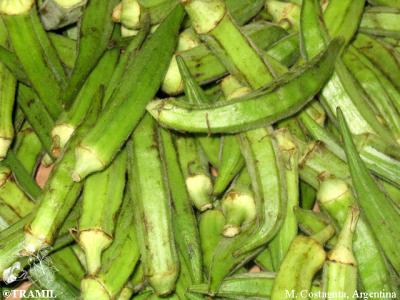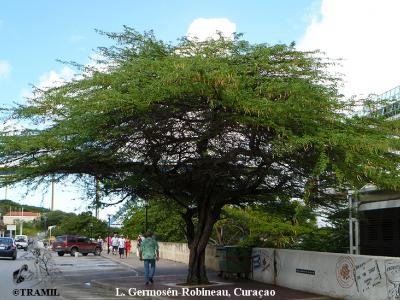(In territories with significant traditional TRAMIL use)
Haiti:
- calalou
Dominica:
- gumbo
- okra
Dominican Republic:
- molondrón
fruit, maceration, eyewashes1
According to the information available:
The use of the fruit for ocular conditions and boils is classified as REC based on the significant traditional use documented in the TRAMIL surveys, the toxicity studies and the scientific information published.
For ocular conditions, there is a risk of increasing the irritation by the application of the maceration of the fruit in eyewashes.
All topical applications, in particular in the eyes, must follow the strictest hygiene measures, in order to prevent contamination or additional infection and to avoid contact with substances that can irritate the conjunctiva.
Ensure adequate washing and cleaning of the fruit, as well as the removal of its external villi; these can cause irritation to the skin and mucosa.
If deterioration is observed in the patient or the ocular symptoms persist for more than 3 days or the infection in the skin for more than 5 days, seek medical attention.
Not for use during pregnancy, breastfeeding or in children under 12 years of age for ocular conditions and 5 years for skin conditions.
The fruits of Abelmoschus esculentus are a relatively widespread food for human consumption.
TRAMIL Work28
For ocular infections:
wash the fruit and remove its external villi; chop 4-5 average-sized fruits (5 cm) and add them to 4 cups (1 litre) of boiled water, leave them to rest until they reach a mucilaginous texture, strain (filter) the preparation with a clean cloth before making an eye wash every 2-4 hours.
For boils:
wash the fruit and remove its external villi. Wash the lesion with boiled water and soap, apply 2-5 grams of crushed fruit on the affected area. Cover with a clean cloth and change every 12 hours.
Preparations must never be stored for more than 24 hours, even if refrigerated.
1 WENIGER B, 1987-88
Encuesta TRAMIL. enda-caribe, Santo Domingo, Rep. Dominicana.
2 CHARLES C, 1988
TRAMIL survey. Movement for Cultural Awareness MCA, Roseau, Dominica.
3 BASU KP, GHOSH D, 1943
Availability of Ca in lady's finger (Hibiscus esculentus), cabbage (Brassica oleracea capitata), drumstick (Moringa oleifera), and amaranth tender (Amaranthus gangeticus). I. Experiments. Indian J Med Res 31:29-31.
4 LENGSFELD C, TITGEMEYER F, FALLER G, HENSEL A, 2004
Glycosylated compounds from okra inhibit adhesion of Helicobacter pylori to human gastric mucosa. J Agric Food Chem 52(6):1495-1503.
5 WOOLFE ML, CHAPLIN MF, OTCHERE G, 1977
Studies on the mucilages extracted from okra fruits (Hibiscus esculentus) and baobab leaves (Adansonia digitata). J Sci Food Agr 28(6):519-529.
6 DEMETRIADES SD, 1956
Chromatographic detection of free amino-acids in normal iron-deficient plants of Hibiscus esculentus L. Nature 177(4498):95.
7 KOSHIOKA M, NISHIJIMA T, YAMAZAKI H, 1996
Endogenous gibberellins in the immature seeds of okra. J Plant Physiol 149(1-2):129-132.
8 BUREAU JL, BUSHWAY RJ, 1986
HPLC determination of carotenoids in fruits and vegetables in the United States. J Food Sci (51)1:128-130.
9 SAKAKIBARA H, HONDA Y, NAKAGAWA S, ASHIDA H, KANAZAWA K, 2003
Simultaneous determination of all polyphenols in vegetables, fruits, and teas. J Agric Food Chem 51(3):571-581.
10 SCHMIDT JH, WELLS R, 1990
Evidence for the presence of gossypol in malvaceous plants other than those in the "cotton tribe". J Agr Food Chem 38(2):505-508.
11 BERRY SK, 1980
The fatty acid composition and cyclopropene fatty acid content of the maturing okra (Hibiscus esculentus L.) fruits. Pertanika 3(2):82-86.
12 BANDYUKOVA VA, LIGAI LV, 1987
A chemical investigation of the fruit of Abelmoschus esculentus. Chem Nat Comp 23(3):376-377.
13 DANIEL M, 1989
Polyphenols of some Indian vegetables. Curr Sci 58(23):1332-1334.
14 OSMAN AM, YOUNES MEG, ATA FM, 1974
Chemical examinations of local plants: Part X. Comparative studies between the constituents of some parts of Hibiscus esculentus Linn (Egyptian okra). Indian J Chem 12(9):1019A.
15 DUKE JA, 1992
Handbook of phytochemical constituents of GRAS herbs and other economic plants. Boca Raton, USA: CRC Press.
16 DUKE JA, ATCHLEY AA, 1986
Handbook of proximate analysis tables of higher plants. Boca Raton, USA: CRC Press. p7.
17 LUCIANO-MONTALVO C, GAVILLÁN-SUÁREZ J, BOULOGNE I, 2011
A screening for antimicrobial activities of Caribbean herbal remedies. Informe TRAMIL. Cuadernos de Investigación del Instituto de Investigaciones Interdisciplinarias de la Universidad de Puerto Rico en Cayey. Cuaderno 16.
18 GEORGE M, PANDALAI KM 1949
Investigations on plant antibiotics. Part IV. Further search for antibiotic substances in Indian medicinal plants. Indian J Med Res 37(2):169-181.
19 VERPOORTE R, DIHAL PP, 1987
Medicinal plants of Surinam. IV. Antimicrobial activity of some medicinal plants. J Ethnopharmacol 21(3):315-318.
20 CÁCERES A, MENÉNDEZ H, MÉNDEZ E, COHOBON E, SAMAYAO BE, JAUREGUI E, PERALTA E, CARRILLO G, 1992
Antigonorrhoeal activity of plants used in Guatemala for the treatment of sexually transmitted diseases. Facultad de Ciencias Químicas y Farmacia, Universidad de San Carlos, Guatemala, Guatemala.
21 CÁCERES A, MENÉNDEZ H, MÉNDEZ E, COHOBON E, SAMAYAO BE, JAUREGUI E, PERALTA E, CARRILLO G, 1995
Antigonorrhoeal activity of plants used in Guatemala for the treatment of sexually transmitted diseases. J Ethnopharmacol 48(2):85-88.
22 YASUKAWA K, YAMAGUCHI A, ARITA J, SAKURAI S, IKEDA A, TAKIDO M, 1993
Inhibitory effect of edible plant extract on 12-O-tetradecanoylphorbol-13-acetate-induced ear oedema in mice. Phytother Res 7(2):185-189.
23 LÓPEZ M, MOREJÓN Z, GARCÍA AI, MARTÍNEZ MJ, 2013
Irritabilidad dérmica primaria de frutos frescos machacados de Abelmoschus esculentus. Informe TRAMIL. Laboratorio Central de Farmacología, Facultad de Ciencias Médicas “Dr. Salvador Allende”, La Habana, Cuba.
24 CAIZA F, AYMERICH R, 2013
Irritabilidad dérmica aguda del liofilizado del fruto de Abelmoschus esculentus. Informe TRAMIL. Laboratorio de Ensayos Biológicos, LEBi®, Universidad de Costa Rica, San Pedro, Costa Rica.
25 CAIZA F, AYMERICH R, 2013
Irritabilidad ocular del liofilizado del fruto de Abelmoschus esculentus. Informe TRAMIL. Laboratorio de Ensayos Biológicos, LEBi, Universidad de Costa Rica, San Pedro, Costa Rica.
26 MORTON JF, 1981
Atlas of medicinal plants of Middle America. Springfield, USA: Charles C. Thomas Publisher.
27 UEDA A, MANDA F, AOYAMA K, UEDA T, OBAMA K, LI Q, TOCHIGI T, 1993
Immediate-type allergy related to okra (Hibiscus esculentus L.) picking and packing. Environ Res 62(2):189-199.
28 CARBALLO A, 1995
Plantas medicinales del Escambray cubano. Apuntes científicos. Informe TRAMIL. Laboratorio provincial de producción de medicamentos, Sancti Spiritus, Cuba.



